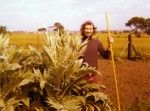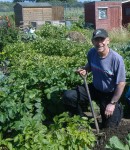
Plotholders John & Val Maule share their memories of Craigentinny Allotments in what we hope will be the first of several ‘Allotment Tales’.
I first acquired an allotment at Craigentinny in 1972, whilst renting a flat in Leith. There was not a waiting list then, and there were several vacant plots when I toured the site to select mine. I was asked how many plots I would like since most of the gardeners had more than one! I chose a plot by the golf course fence on the area currently occupied by part of the communal garden.
Interestingly, the layout of the site was then somewhat different to the present arrangement The area currently occupied by the first five plots, at the entrance to the site, was then used by Edinburgh Corporation Parks Department to raise bedding plants for Princes Street gardens. Wallflowers were the predominant crop and there were usually a few left over, which plotholders were encouraged to take. I was told that there used to be a communal hut, built from an old railway wagon, which was positioned near the gate, but the structure had been burnt down by vandals. The site extended further to the south, into the area which is now a willow and birch plantation beyond the fence. Plots at this end of the site frequently became flooded during wet weather and were the first to become frosted in the winter, so when the Corporation gave up the ground by the gate it was decided to create more plots here and abandon the area at the other end of the site.
The population of plotholders was then quite different compared with today. Allotments were strictly an old persons’ domain, dominated by men, who traditionally grew nothing but common vegetables, in straight rows from one side of the plot to the other. Growmore and pesticides were used extensively, often to excess, and there was keen competition to grow the largest possible vegetables regardless of the final taste. In those days, it was hardly economical to grow vegetables since for 50p (£2 in today’s money) one could buy enough fruit and vegetables to last a small family for a week, so the cultivation of allotments was very much a hobby rather than a means of producing food to eat. When we started cultivating our new plot (without using Growmore), we not only included some flowers but also experimented with unusual vegetables such as cardoons, salsify and scorzonera. This somewhat “unconventional” approach was met with a mixture of amusement and scepticism! Old timers laughed at our cultivation of flowers and said they had never heard of anyone growing dried flowers. Our next door neighbour had a drink problem, which was evident by the large number of beer cans he had thrown into our plot and which had become buried over the years. As I cleared the plot, my fork would frequently emerge from the soil with a can attached to each prong! His own plot was totally overgrown because his main interest was sitting in his hut drinking. His hut was also used to make wine and homebrew. He would buy vegetables from the shops on his way home and pretend to his wife that he had grown them! This went on for several years until his wife made an unexpected visit to the allotment and that was the end of his “gardening” career.
The Corporation’s approach to allotment holders was then more relaxed than today. Because there was not a waiting list for plots, there was not the pressure on tenants to keep their plots in good order. Several plots, particularly towards the bottom of the site were totally overgrown, with grass up to waist height. There was a German lady, who took advantage of this abandoned ground to sunbathe. One of the old timers had a nasty shock when, armed with a toilet roll, he had disappeared into the long grass only to find the lady completely naked apart from her black wellington boots. Far from being embarrassed, she was indignant at his shocked reaction, contending that it was her right to take full advantage of nature’s sunshine! In those days, plotholders referred to each other just by their surnames and I think the gentleman involved was simply called Baxter.

Our plot did not come with a hut and so initially I had made a toolbox out of wood salvaged from a garden shed, being demolished by a friend in Findlay Gardens. Most of the plots did have sheds and it was traditional to have a photo of the Queen hanging inside, so that when I could afford to build a shed for myself, one of my first acquisitions was a photo of the Monarch. The range of sheds was then as varied as it is today. One plotholder in particular had a shed which occupied a good third of his plot. He used this shed to breed budgerigars before the Council banned the keeping of livestock on allotments. I can remember one plot which did not have a hut but which was totally given over to the cultivation of garlic. The plotholder harvested the whole crop in one go and the smell was overpowering! As soon as I was able, I replaced the toolbox with a shed, which occupied a position near where the present toilet stands. We planted a tree which still grows near the recycling area and one of the old gardeners gave us a cutting of honeysuckle to grow over the hut. It provided a host of wonderfully fragrant flowers.

After many years of happy gardening we noticed that our plot was becoming waterlogged. Fine for growing rice but not much good for our vegetables and flowers! A friend in Portobello, who had a plot at Craigentinny during the war, could remember there being a stream which plotholders used to water their gardens. It now seemed as if there had been a localised change in the water table which affected our plot and the one next door. The Council agreed to provide us with a replacement and, once again, the absence of a waiting list gave us the choice of several vacant plots. This time, our chosen plot came with a shed, in the form of a well preserved World War 2 Anderson shelter.

Our daughter, who is now grown up, raised some trees from seed and these have now matured and, in some cases, have been felled and used as logs for the fire. All our children had areas on the plot at some stage or other and now our grandchildren have taken over. Naturally, we took a cutting from our beloved honeysuckle, to grow over the shed. The old gardener, who originally gave it to us, has long since passed away but his honeysuckle grows on.
John & Val Maule
December 2009